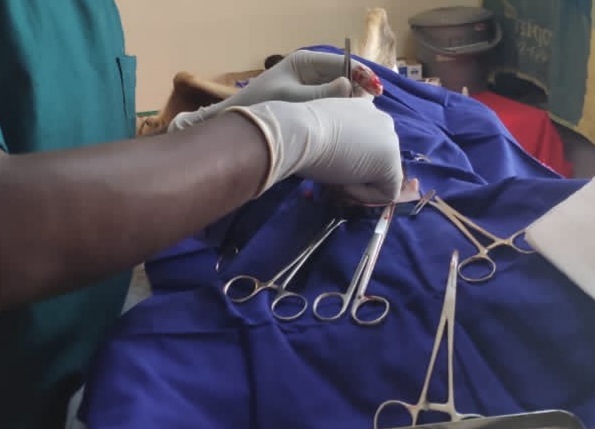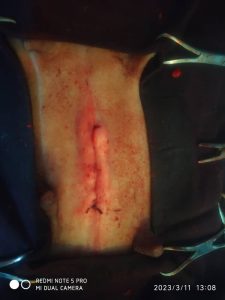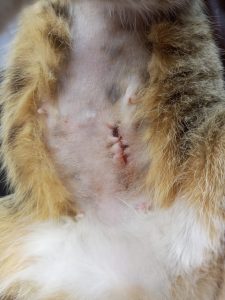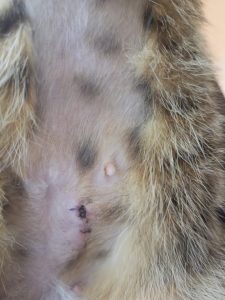After surgery client management of surgical wounds in pets.
Introduction
When it comes to the well-being of our furry companions, various circumstances may necessitate surgical intervention. Whether it’s to regulate breeding, enhance quality of life, or address health concerns such as tumor masses or hernias, elective procedures like spaying/neutering, tumor extraction, or hernia repair become crucial decisions for pet owners. At Vetlit Mobile Veterinary Services, we understand the significance of these procedures and the apprehension that may accompany them. That’s why we prioritize not only the surgical expertise but also the post-operative care and recovery process.
Our work
Following any surgical procedure, a clean and meticulously managed wound is essential for your pet’s recovery. We take pride in ensuring that the surgical site is sterile, tidy, and well-cared for. Enhanced by our dedication to compassionate care and convenience, Vetlit Mobile Veterinary Services brings the expertise of a traditional veterinary practice with a focus on personalized attention and professional proficiency. We cater to the diverse needs of your beloved pets, ensuring their well-being remains our top priority. Our comprehensive range of services encompasses a spectrum of procedures meticulously conducted. From routine check-ups to specialized surgeries, including castrations, spaying, tumor extractions, hernia repair, gastropexy, enterectomy, total ear ablation, and beyond, we deliver excellence in veterinary care. However, we recognize that as a pet owner, you may have concerns about your fluffy friend’s post-surgery care and recovery.
This article is crafted specifically for you, aiming to offer invaluable insights and enhance the overall experience with our cosmetic veterinary surgeon. We prioritize your trust and satisfaction, and we commit to exceeding your expectations every step of the way. We aim to alleviate your worries by providing comprehensive guidance on aiding your pet’s recovery journey. From understanding what to expect after surgery to meticulous wound care and recognizing signs of potential complications, we’ll cover everything you need to know to support your beloved companion during this critical period. Your pet’s comfort and well-being are our utmost priority. We are committed to empowering you with the knowledge and resources necessary to ensure a smooth and successful recovery process.
What to expect after surgery.
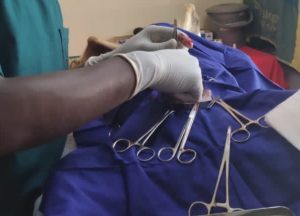
Vetlit neutering a female dog.The surgeon made an incision into the abdomen to access and remove the ovaries and uterus.
Following surgery, your furry friend will bear a surgical wound in the area accessed for the procedure, or where the lesion was located, depending on the nature of the surgery performed. Our expertly crafted surgical wounds, such as those from neutering, and explorative laparotomies, generally exhibit excellent healing potential. Our commitment to surgical precision ensures that these wounds are typically cosmetic, sterile, and meticulously neat, with edges well-apposed where necessary.
Immediately following surgery, your pet may exhibit signs of grogginess, sleepiness, and mild wobbliness, which are common effects of anaesthesia. Rest assured, our commitment to your pet’s well-being extends beyond the operating table; our surgeon will remain present until your pet has fully emerged from anaesthesia. He/she will then provide appropriate pain management and antibiotics to ensure comfort and mitigate infection risks. During the initial 24 to 48 hours post-surgery, it’s imperative to provide a calm and comfortable environment for your furry companion. The pet should avoid strenuous activities such as running, jumping, or playing to facilitate proper healing. Instead, offer a quiet space where your pet can rest undisturbed and embark on their journey to full recovery.
The healing process for these wounds typically spans around 21 days, contingent upon the tissue type and location. The initial 7 days post-surgery are of paramount importance in monitoring the wound’s progress. Strict adherence to the veterinarian’s instructions regarding medication dosage and administration is crucial for your pet’s optimal recovery.
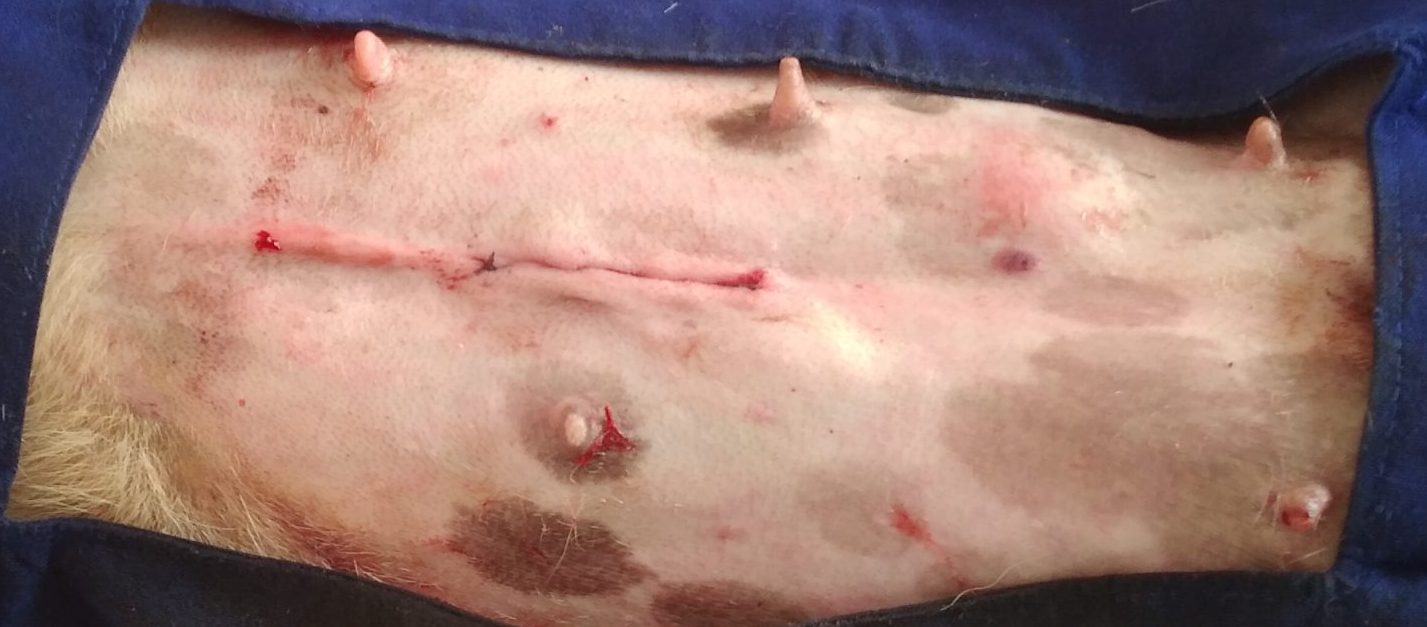
Our good surgical wound with nicely apposed edges. This was a surgical wound created during an explorative laparotomy. These kind of wounds easily heal well.
Wound Care
It’s crucial to monitor the wound daily for any signs of complications like redness, swelling, or discharge, and to promptly report any concerns or changes in appearance. Keeping the wound clean and dry is essential, and we may suggest using an Elizabethan collar to prevent your dog from licking or biting at it. This precaution is vital because exposing the wound to saliva can introduce bacteria and impede the healing process.
Furthermore, our cosmetic veterinary surgeon excels in employing highly specialized skills and utilizes specific technical suture patterns to conceal the wound beneath the skin, effectively preventing any potential licking. His technique significantly reduce the likelihood of complications, particularly scar tissue formation. In most cases, the surgical wound will be closed with sutures or staples. We will let you know when they can be removed, which is usually 7-14 days post-surgery. It is important not to attempt to remove the sutures or staples yourself. Sutures that don’t require removing may be used for some procedures such as neutering, gastropexy, or laparotomy.
- A surgical wound created during a neutering surgery. The picture was taken immediately after surgery. The redening and swelling, immediately after surgery, is a good indicator of good healing.
- A neuter surgical wound in a cat, five days after surgery. Note the dryness and cleanliness of the wound
- Neuter surgical wound in a cat, 8 days after surgery. Note, the sutures have started disappearing. Absorbable sutures were used in this patient.
Signs of Complications.
Owners should monitor surgical wounds in dogs carefully. Signs of infection such as redness, swelling, discharge, or odor are indicators of a possible infection. Additionally, owners should look for behavioral changes, anorexia, and any other signs of discomfort that suggest the animal is not healing appropriately or hasn’t resumed its normal activity. If you notice any of these signs, please Contact us immediately for further guidance.
In some cases, the wound may open up or a portion of the sutures or staples may come loose. This is not common, if it does happen, then we will need to re-evaluate the wound and determine the appropriate course of action.
Other Recommendations.
Dogs or cats with surgical wounds require special care to ensure that they recover swiftly and smoothly. Owners must follow our instructions on medication, feeding schedule, exercise limitation, and wound care.
Additionally, proper wound management necessitates the administration of antibiotics or other therapeutic interventions, depending on the severity of the wound. Moreover, owners should keep the wound site dry and clean and avoid any environmental contaminants.
In conclusion, proper surgical wound management is vital for the successful recovery of your pet. Following our advice for wound care and monitoring for signs of complications will help ensure a positive outcome. If you have any questions or concerns about your pet’s surgical wound, do not hesitate to Contact us. if you want to Request an Appointment please visit our home page.
Your pet’s health is our pride.

